Rescue on Everest completed
All climbers from the high camps on Mount Everest are safe. In the morning the last 17 climbers, who had been stranded at Camp 1 at 6,100 meters, nine Sherpas and eight foreigners, were flown down to the valley by helicopter. An official of the Nepalese Tourism Ministry said, more than 200 climbers had been rescued on Everest. It was the most extensive rescue operation in the history of high altitude mountaineering. According to department reports, at least 19 climbers, including five foreign nationals, have been confirmed dead in two avalanches. It seems that this figure also includes three Sherpas who reportedly died in the Khumbu Icefall during an aftershock on Sunday.
![]() read more
read more
Many question marks after the earthquake
Day three after the devastating earthquake in Nepal: The death toll in the country has risen to almost 4,000, and it is continuously increasing. An end of the bad news is not in sight. Still information focusses on the most heavily hit capital Kathmandu and the region around Mount Everest. From the other regions of the country, messages are barely trickling in. German trekkers report that debris flows also occured on the Annapurna Circuit on Saturday. Many trekkers are reportedly waiting on their way around the eight-thousander Manaslu for being evacuated by helicopter. The base camp at the foot of Annapurna was hit by an avalanche on Saturday. “It just about buried us in our tents, we had to use our knives to cut our way out. After that, myself and two sherpas had to do a rescue of a teammate”, Canadian mountaineer Al Hancock said.
Helicopter airlift
At Mount Everest, the rescue of the climbers, who were stranded at Camp 1 above 6,000 meters, is standing just before the end. Only 15 mountaineers are still waiting to be flown to the valley by helicopter. All Monday long, there was an airlift to Camp 1, where initially about 150 climbers had been cut off from descent. Continously the helicopters started and landed. The “Icefall Doctors” have stopped their work on the route through the Khumbu Icefall for fear of aftershocks. Reportedly, three Sherpas died in the ice labyrinth during an aftershock on Sunday. It is still not clear how many climbers were killed in Everest Basecamp by the huge avalanche from Pumori, that was triggered by the earthquake on Saturday. Figures currently vary from 16 to 19. German climber Jost Kobusch survived. The 22-year-old took this video of the avalanche:
Stop on the Tibetan north side of Everest?
The situation on the Tibetan north side of Mount Everest is unclear too. The official news agency Xinhua reports that China has cancelled all expeditions this spring. Xinhua relies on a high-ranking official who said that more aftershocks were expected next month. Today, Chinese officials discussed with the expedition leaders in “Chinese Base Camp”. According to my information, there will be another meeting on Tuesday morning. The German couple Alix von Melle and Luis Stitzinger has abandoned their Everest expedition on the north side on their own accord. “We cannot turn a blind eye to the suffering thas happened (in Nepal)”, Alix and Luis write on their homepage. “Moreover, we do not want to be the reason why Nepalese helpers, cooks and Climbing Sherpas have to stay here and cannot go home to their families to see if everything is alright.”
China reportedly (!) cancels all spring climbs on Everest
The Chinese state news agency Xinhua reports that China has stopped all expeditions on the north side of Mount Everest because of the earthquake disaster in Nepal. Still, there was no confirmation by expedition leaders. However, there were earlier reports that officials negotiated with the expedition leaders about the consequences of the earthquake for the spring season on the north side. I got the information that there will be another meeting with the authorities in Chinese Basecamp on Tuesday morning. So I’m not sure that the Xinhua report is right.
Von Melle and Stitzinger abandon Everest expedition
Actually, they wanted to climb Mount Everest without bottled oxygen this spring. Actually, they were on the Tibetan north side of Everest where no one was injured by the earthquake. Nevertheless, the German couple Alix von Melle and Luis Stitzinger finished their Everest expedition, before they could make any attempt on the mountain. “Although there is no damage to people or property on the north side, we cannot turn a blind eye to the suffering thas has happened”, Alix and Luis write on their homepage. “Moreover, we do not want to be the reason why Nepalese helpers, cooks and Climbing Sherpas have to stay here and cannot go home to their families to see if everything is alright. Under the circumstances, we think it’s wrong to continue our expedition. Even a possible summit success would feel vapid and invalid. We couldn’t find any joy in it.”
![]() read more
read more
Video of the avalanche that hit Everest Base Camp
Barely no chance to escape
The quite inconceivable really happened. A huge avalanche from Pumori, triggered by yesterday’s earthquake in Nepal, hit the Base Camp at the foot of Mount Everest at full force. The seven-thousander is located just opposite the highest mountain in the world. But hardly anyone had expected that an avalanche from Pumori would reach the edge of the Khumbu Icefall. “I ran and it just flattened me. I tried to get up and it flattened me again. I couldn’t breathe, I thought I was dead,” said George Foulsham, a mountaineer who lives in Singapore. The 38-year-old marine biologist was lucky and survived. It is not yet totally clear how many climbers lost their lives in Base Camp.
![]() read more
read more
Rescue runs on Mount Everest
My heart is heavy. My thoughts are with the people in Nepal – and also with the climbers on Mount Everest. After the devastating earthquake on Saturday, the death toll is rising continuously. Meanwhile, it’s more than 2,000 across the country. And also from the base camp on the Nepalese side of Everest more and more victims are reported. As reported before, yesterday’s earthquake had triggered a huge avalanche from the seven-thousander Pumori vis-a-vis Everest that had hit the Base Camp at 5,300 meters. Today, the area was shaken by strong aftershocks of magnitude 6.7 on the Richter scale.
![]() read more
read more
Nepal devastated by earthquake, avalanche on Everest
The number of victims of the devastating earthquake in Nepal is increasing every hour – now over 1100. In the capital Kathmandu, but also in the nearby towns of Patan and Bhaktapur, many houses and buildings collapsed, including centuries-old temples. The tremors reached a magnitude of 7.8 on the Richter scale, the center of the quake was 80 kilometers north-west of Kathmandu. At least ten climbers were killed at the foot of Mount Everest after the quake had triggered a massive avalanche on Pumori. The seven-thousander is located vis-a-vis the highest mountain in the world. The situation is dramatic.
![]() read more
read more
Breaking news: Strong earthquake in Nepal, avalanche hits Everest BC
Terrible news from Nepal: A severe earthquake of magnitude 7.9 has killed several hundred people. At Mount Everest, the shocks triggered a huge avalanche. The snow masses reportedly released from the seven-thousander Pumori and met the Everest Base Camp. According to the Nepalesse government at least eight climbers were killed. The number could rise, said a representative of the Ministry of Tourism. On the Tibetan north side of Everest apparently nothing happened. “The quake was clearly felt in Everest BC, it occurred smaller landslides and debris flows. Nobody was hurt. We are doing well”, wrote German climber Luis Stitzinger.
P.S. Follow my tweets! (right side of the blog)
Baumann: “Families of Everest victims still need help”
There was no climbing on Mount Everest on this Saturday. At the Base Camp at 5,300 meters, more than 300 western climbers and an equivalent number of Sherpas commemorated the 16 Nepalis who had been killed in the avalanche in Khumbu Icefall exactly one year ago. It was the worst avalanche disaster in the history of Everest. The German climber and physician Matthias Baumann had witnessed the tragedy at the Base Camp. Later he visited the families of the victims and launched a relief campaign for them. In March, the 43-year-old trauma surgeon from the city of Tuebingen traveled again to Nepal. He distributed money to the families of the victims and launched financial sponsorships to guarantee the education of the avalanche victims’ children.
Matthias, a year ago, you were at the Base Camp of Mount Everest, when the avalanche released in the Khumbu Icefall. You were among the doctors who first treated the injured climbers. Are you still thinking of what happened on 18 April 2014?
![]() read more
read more
Rather far on the right side
Apparently, the new route through the Khumbu Icefall is more than a little course correction. That is indicated by the images that the US guide Garrett Madison has published in his blog. Expedition members of his Madison Mountaineering team had flown over the icefall above Everest Base Camp by helicopter and had looked from the air where the so-called “Icefall Doctors” set up the route for this spring season. The images show that the route leads – seen from below – much further to the right side of the ice labyrinth than expected. Closer to Nuptse, further away from the West Shoulder of Everest, from where an ice avalanche had released on 18 April 2014 that had killed 16 Nepalis. “It appears that climbers will have to negotiate broken ice as before, and perhaps more vertical ladders”, Garrett wrote adding that there was at least one section that had four vertical ladders tied together to ascend up a very large ice cliff.
![]() read more
read more
Jamling Tenzing Norgay: “My father would be shocked”
I owe Jamling Tenzing Norgay my first experiences in the Himalayas. I met the son of the first man who made it to the top of Everest in 2001 when he presented his book “Touching My Father’s Soul” in Germany. In 1996, Jamling had followed in his father’s footsteps by reaching himself the summit of the highest mountain on earth. Norgay’s book was the first to discuss from the Sherpas’ point of view the May 1996 disaster on Everest, in which twelve climbers had died, most of them clients of commercial expeditions. At the end of our meeting in Munich, Jamling said: “If you want to come to Nepal someday, contact me! Then I’ll help you to organize the trip.” He kept his word. In 2002, the International Year of the Mountains, I trekked to the base camp on the Nepalese side of Everest. Today Jamling Tenzing Norgay is a sought-after speaker. I asked the 48-year-old what he expects of this year’s climbing on Mount Everest.
![]() read more
read more
Goettler and Co. plan new Everest route variant
This year, the Tibetan north side of Mount Everest works like a magnet to German professional climbers. David Goettler has announced that he also wants to climb the highest mountain in the world from the north this spring, along with his German friend Daniel Bartsch and the Canadian Raphael Slawinski. “If everything runs perfectly, we want to try a variant or a new route. Others have to decide how it is called at the end”, the 36-year-old tells me on the phone. The planned ascent route runs near the normal route, first on the left, later crossing it between Camp 2 (7500 meters) and 3 (8300 meters), leading to the “Great Couloir” (also called Norton Couloir). “This would allow us to avoid possible traffic jams at the rocky steps on the normal route”, says David. The trio wants to climb without Sherpa support and without bottled oxygen.
![]() read more
read more
Brice: “Detrimental to Nepalese tourism”
The decision of the Nepalese Government to extend last year’s Everest permits until 2019 came late, very late. “The Everest season starts in a few days, my staff are already on their way to Base Camp, so our planning has been going on for months”, Russell Brice, head of the New Zealand expedition operator Himalayan Experience, writes to me. “Food, oxygen and equipment are already in the Khumbu and members will be arriving in Kathmandu as from Monday next week.” He has some members that were at Everest last year coming back this year, says Russ. There is no sign of euphoria in his words about the decision to prolong the permits.
![]() read more
read more
Everest permits extended
This decision was really overdue. The Nepalese government finally decided that the permits to climb Mount Everest in 2014 remain valid until 2019. Shortly after the avalanche in the Khumbu Icefall on 18 April 2014 that had killed 16 Nepalese climbers, the spring season de facto had been terminated. More than 330 foreign climbers left the highest mountain in the world, without having set foot on it. Even then government officials in Kathmandu announced that the permits for the 39 expedition groups would retain their validity for five years. However, the words were not followed by deeds. Instead, there were rumors about government plans to extend the permits only for groups. The climbing scene was outraged rightly. If in this case e.g. only one climber would have used the permit of 2014 to climb Everest in 2015, the other group members not in attendance would have been empty handed. Now, this regulation is apparently off the table.
![]() read more
read more





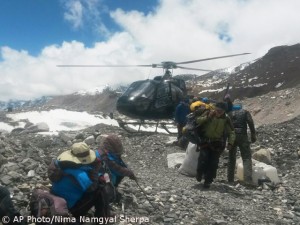
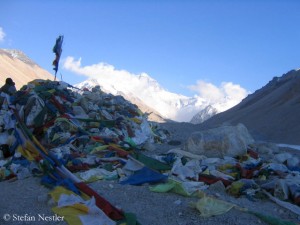
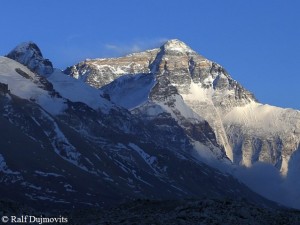
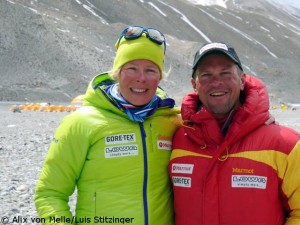
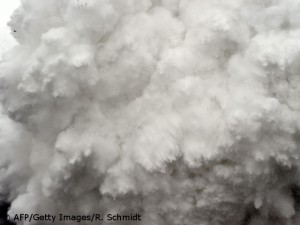
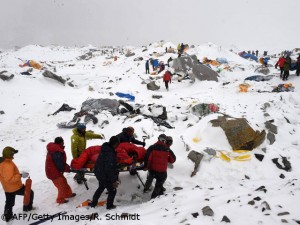

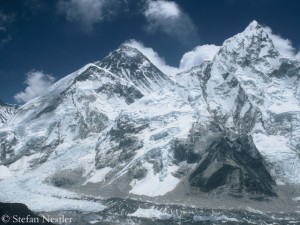
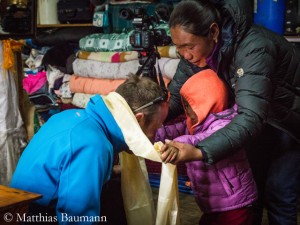
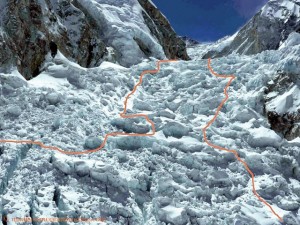


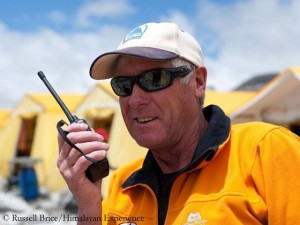






Feedback